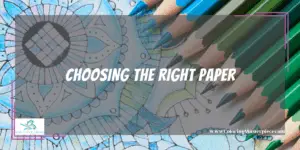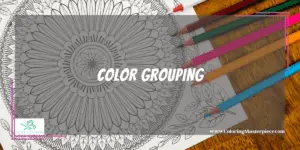Welcome to the world of Adult Coloring! And if you’ve been coloring for a while, come on in any way; the door is open friend! Whether you’ve started getting into coloring for the mindfulness and stress relief benefits, or maybe you’re looking to impress your friends with some original coloring, every beginner could use a few quick tips to help them achieve their goals!
Choosing The Right Paper

The best art supplies don’t count for anything if you’re using trash paper. First and foremost, aim for a thick card-stock or card-stock-like paper. Most well-worthy adult coloring books use appropriate paper. However, if you’re printing out your coloring pages from home, please do yourself a favor and invest in a heavier paper that will hold on to all the layers of pigment you’ll be putting into the page. Additionally, if you’re planning on using a wet medium like markers, gel pens, or watercolors, then you’ll want slightly glossy paper for the inks to pool and mix. For dry mediums like crayons, colored pencils, and pastels, you’ll want a matte finish paper so the pigment can softly lay into the tooth of the page.
READ The Coloring Page
Whether or not there are actual words on the page, it pays dividends to read the shapes, lighting, and space of the page before jumping in. Often it takes a minute to visualize not just specific colors but shadows, repetitive objects, and open areas before grabbing our colors.
No “Flat” Colors
Regardless of a specific color, by only coloring one layer of color on an object, the color turns out flat and muted. This is because there aren’t enough dynamics or pigment layers for the object to pop out of the page. Avoid flat colors by using layering and the three-tone rule.
Lightly Layer
Applying color lightly onto the page instead of pressing with intentional pressure saves the tooth of the paper and allows the colorist to use more layers of color. The added layers of color, when lightly applied over each other, create a bolder and more vibrant color.
Coloring Outside-In
With whatever object or subject you are coloring, by starting near the lines outside of the coloring area and coloring your way to the inside of the object or subject, you decrease the margin of error for coloring outside the lines.
Create Swatches
A swatch chart is a separate piece of paper that colorists use to test their colors and ideas before coloring on their project. Swatches help us visualize what is going to be on the project page as well as help us practice the technique used in creating the desired visual.
Blend
Blending allows colorists to create more dynamic colors and unique visuals that pop out from the page. Blending can be done in several ways. The two easiest means of blending can be done by lightly coloring one color into another color using a layering technique. The second means of blending can be done by using an additional tool such as a blending stump or blending solvent.
Three Tone Rule
Yes, breaking the rules is an acceptable means of artistic freedom; however, if you’re starting and looking to add some easy dynamics to your page, the Three Tone Rule will help. Instead of coloring an object such as a leaf with one shade of green, mix it up a little. By laying tones of light green, then medium green, and lastly, dark green, the leaf will show more natural dynamics because of the highlight tones and shadow tones being created.
Angle The Tip
This tip about tips is more geared towards colored pencils but also applies to crayons, markers, and oil pastels. Instead of coloring with only the tip of the pencil, angle it to the side to increase your surface area of color and passively keep your pencil sharp while you color!
Oval Pattern
Coloring in an oval or circular pattern with your hand allows for a more even application of the pigment. This is especially true with wet mediums such as markers and paints, where another overlapping layer of color can create streaks when drying the page. By using a circular motion, the pigment is more evenly spread out over the coloring area and reduces streaking, unlike a back-and-fourth coloring motion.
Hatching
Looking to do some texture work with line color? Hatching is a technique where colorist uses their coloring medium to draw/color straight parallel lines over a given color area. Hatching is great for mixing in darker textures near corners or bold lines to create shadows while still letting the original background color through.
Cross-Hatching
Just like hatching, cross-hatching is great for texture and shadow work while not destroying the original colors beneath it on the page. What separates cross-hatching from hatching, however, are the perpendicular lines that cross over the original parallel lines done by hatching.
Gradients
Like blending and the three-tone rule, creating gradients with your colors is a great way to add dynamics to your coloring. Gradients can be done with an array of colors, but the easiest way to start doing gradients is to abide by the three-tone-rule and color the lightest values first and use mid-tone hues to fill in space, eventually coloring your darkest values keeping space for each color in your color grouping to show before transitioning into the next color.
Burnishing
Remember the rule about breaking the rules? Well, burnishing is a direct break from the “color lightly” rule. Typically colorists will take their highlight values such as light greens, light blues, rosy pinks, yellows, or any lighter value colors and press them into the page over a color area AFTER all the lighter layers of color in every applicable tone have been laid down. By hard pressing a previously used lighter color over the color area afterward, the colors blend smoother and often with a shinier texture.
Highlights
Highlights are done by coloring your light values first or even leaving some of the natural white from the page uncolored and then coloring progressively darker values around it afterward. Additionally, colorists can burnish the colored object with their highlight color after all other layers have been colored for a more pronounced highlighter effect.
Color Grouping

If you’re not familiar with color theory, don’t stress. Instead of sinking hours into YouTube videos or even sinking money in traditional art education, do yourself a favor and get your hands on a color wheel. Even a free printed image of a color wheel from Google Images will work. Either way, having a color wheel on hand helps colorists visualize and reference the different relationships between colors and light values. It may not work wonders immediately, but the exposure will surely boost your coloring IQ.
Color On Top of the Lines
Coloring OVER the lines and coloring ON TOP of the lines are two different cases. When it comes to coloring on top of the lines, colorists can turn the printed-out coloring book into an art piece. By laying pigment over the bold, black lines of a coloring page or book, the picture appears more natural, as if the colorist had drawn the image itself as opposed to leaving the divider lines visible to viewers. Feel free to experiment with dark tones of color and light tones of color on top of the printed lines; both can work just so long as you continue to lightly layer your color.
Take Care of Your Supplies
Coloring won’t be any fun if your coloring supplies are trashed and neglected. Furthermore, the coloring supplies themselves will lose a great deal of effectiveness without some simple upkeep and protective habits. Each art supply is a little different, but for the most part, art supplies should be stored away from any direct light source and put into an organized container. Additionally, though spills happen, try not to drop your colored pencils, markers, crayons, paints, etc.…
Take Care of Your Hand
Please don’t push yourself to color if your hand is hurting or cramping. Yes, you’ll be getting some more practice time in on completing your project, but at the cost of your long-term art health. Art is a life-long hobby, a marathon if you will; don’t burn out your coloring hand before it’s too late.
Take Care of Your Brain
One of the best parts of adult coloring is the mindfulness and stress relief that comes with actively coloring. Just like our hands, it’s more sustainable to take care of our brains with some simple healthy habits like drinking plenty of water, getting good quality sleep, and engaging with other coloring hobbyists to ensure the life-long hobby and health of our coloring fascination.
Experiment
If artists are known for one thing, it’s breaking their own rules to discover something else. Don’t the fear of making a mistake stop you from falling upon a serendipitous discovery with your art? That’s the point of art, creation, and serendipity.
Take Your Time
Art is a marathon, not a sprint. Rushing through your coloring will show, and it will show poorly. Often just trying to get it done doesn’t work. The picture turns out sloppy, and the viewer can tell you ran out of patience at a certain point. If you don’t feel like coloring, take a break; that way, when you come back, you are refreshed and ready to enjoy the process of coloring, not just the accomplishment of coloring.
Check out more tips HERE.
Maximize the benefits of coloring with my free adult coloring eBook and sign up for my email newsletter HERE!
Disclaimer: The information provided by ColoringMasterpiece.com (“The Site”) is for general informational purposes only. All information on the Site is provided in good faith, however, we make no representation or warranty of any kind, express or implied, regarding the accuracy, adequacy, validity, reliability, availability, or completeness of any information on the Site. Under no circumstance shall we have any liability to you for any loss or damage of any kind incurred as a result of the use of the Site or Reliance on any information provided on the Site. Your use of the Site and your reliance on any information on the Site is solely at your own risk. This blog post is for educational purposes only and does not constitute legal advice. Please consult a legal expert to address your specific needs.
Terms and Conditions: https://coloringmasterpiece.com/terms-and-conditions/

